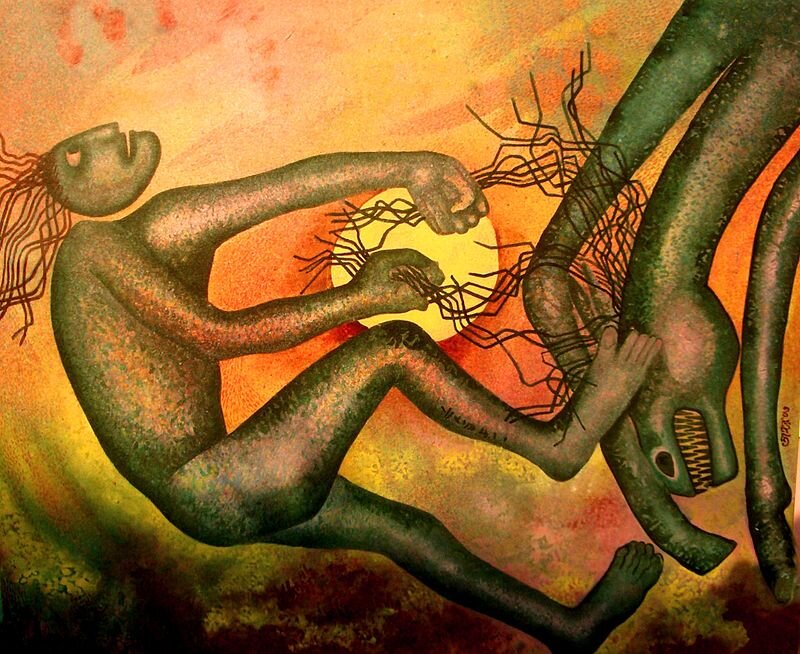
Water Colors
Amrita Sher-Gil (30 January 1913 – 5 December 1941) was an eminent Hungarian-Indian painter. She has been called "one of the greatest avant-garde women artists of the early 20th century" and a "pioneer" in modern Indian art. Drawn to painting at a young age, Sher-Gil started getting formal lessons in the art, at the age of eight.
This delicately rendered watercolour was painted by Sher-Gil when she was only ten years old.
Inscribed 'BRING TO ME DILAH THE REJECTED ONE' lower centre and further signed, inscribed and dated 'Amrita Rajzotta / 10 Loes horambom / Simla, India, 1923, Aprilles' indistinctly on the reverse.

Little Girl In Blue
The Little Girl in Blue is deceptively pioneering as is Sher-Gil’s entire body of work in the context of Indian art. This can be seen in its tight avant-garde framing and illumination of the figures. The Little Girl in Blue assimilates diverse visual cultures of Europe and India. Stylized and powerful in its presentation, set against a backdrop of a park or woodland around Amritsar, the work is both unequivocally modern and decidedly Indian at the same time. The color palette of the female figures is distinctly Indian, while the treatment of the trees and the background is executed in a post-impressionist style.


Three Pujarins
Jamini Roy, a prominent Indian artist from West Bengal, started painting when he was only 16 years old in the year 1903. Having taken a diploma in art from Government College in Calcutta, he soon realized that he needed to draw inspiration, not from Western traditions, but from his own culture, and so he looked to the living folk and tribal art for inspiration. He was most influenced by Kalighat Pat. He created a masterpiece when he painted three almond-eyed priestesses and he called it Three Pujarins

Mother and Child
Jamini Roy is one of the most revered and celebrated Indian painters whose artistic originality and contribution to modern Indian art in India is unparalleled. He is among nine artists whose works were declared national treasures by the Government of India in the 1970s for their artistic brilliance. This also meant that by law, his work cannot be exported outside India.

Mother & Child 2
By Jamini Roy

Black Smith
Jamini Roy is also described as an art machine because he produced 20,000 paintings in his lifetime which is about 10 paintings daily but made sure his artistic aims remained the same. His underlying quest was threefold: to capture the essence of simplicity embodied in the life of the folk people; to make art accessible to a wider section of people, and to give Indian art its own identity.


Confrontation
Jahar Dasgupta (born in Jamshedpur 1942) is an Indian painter. His childhood spent in Jamshedpur where at the small age he used to draw elephants, dogs, trees on the floor. At the age of 9, he drew Stalin face and Ma Sarada Devi on the wall. This took the attention of his parents and they decided to send him to some art school. In 1960 he was admitted to Visva-Bharati University at Santiniketan, the place of Rabindranath Tagore.

Mermaid in Lotus Pond - III
Going to Santiniketan was a turning point in Jahar’s life. In Kala Bhavana, he took his primary lessons under mentors like Nand Lal Bose, Ramkinkar Baiz, and Benode Behari Mukherjee. In 1964, he obtained a diploma from Kala Bhavana. Jahar Dasgupta had developed his individual style in paintings and drawings. Previously he has painted in oil medium and now he mainly works in ink, pastel, and acrylic color.
Mermaid in Lotus Pond is a style of mythological painting by Johar Das Gupta.

Flautist
Lately, Jahar’s drawings have been mostly done in dry pastel both in monochrome of black and white. The canvases in acrylic open up various aspects of ideal beauty. The widespread nature of rural Bengal reveals its colorful faces. The nature is transformed into the supernatural. These paintings narrate full of life, love, spirit, joy, and fantasy.

Shakuntala
Shakuntala or Shakuntala looking for Dushyanta is an epic painting by celebrated Indian painter, Raja Ravi Varma.
Ravi Varma, depicts Shakuntala, pretending to remove a thorn from her foot, while actually looking for her husband/lover, Dushyantha, while her friends call her bluff.
Raja Ravi Varma (29 April 1848 – 2 October 1906) was a celebrated Malayali Indian painter and artist. He is considered among the greatest painters in the history of Indian art for a number of aesthetic and broader social reasons. Firstly, his works are held to be among the best examples of the fusion of European techniques with a purely Indian sensibility.

The Milkmaid
Raja Ravi Varma’s works are held to be among the best examples of the fusion of European techniques with a purely Indian sensibility. While continuing the tradition and aesthetics of Indian art, his paintings employed the latest European academic art techniques of the day. He was also notable for making affordable lithographs of his paintings available to the public, which greatly enhanced his reach and influence as a painter and public figure. Indeed, his lithographs increased the involvement of common people with fine arts and defined artistic tastes among common people for several decades.

Tamil Girl
Paintings by Tamil artist Ilayaraja has breathed life into the faces and lives of uncaptured people, the common crowd in everyday moments of life. Exquisite innocent expressions with delicate play of light and fine details captivate with its like realism. With a reflection of his thoughts, each painting reaches out with the naive eyes of its subjects engrossed in their own little world of regular work.

Tamil Girl 2
Paintings by Tamil artist Ilayaraja has breathed life into the faces and lives of uncaptured people, the common crowd in everyday moments of life. Exquisite innocent expressions with delicate play of light and fine details captivate with its like realism. With a reflection of his thoughts, each painting reaches out with the naive eyes of its subjects engrossed in their own little world of regular work.

Glow Of Hope
Seventy years ago, a young, demure girl stood still for three hours with a lamp in her hand. She was posing for a work of art being created by her father S L Haldankar. This watercolour masterpiece, popularly known as Lady with the Lamp or Glow of Hope has been a star attraction in the Sri Jayachamarajendra Art Gallery in Jaganmohan Palace in Mysore for nearly 60 years now. The sensitivity, simplicity, soft and subtle colours used as well as the ethereal depiction of the light reflecting from the fingers, has made this painting a highly-regarded work which is renowned worldwide.

Woman
By M.F. Hussain

Lady with Veena
By M.F. Hussain

Gandhi Ji
By Nand Lal Bose

Vendor Boy
By Satish Gujral

Bharat Mata
By Abanindranath Tagore





















